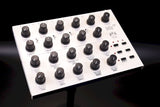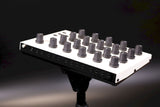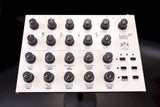Bella is a monophonic synthesizer with an all-analog signal path, paired with a lo-fi digital drum synthesizer. These two sections are controlled by an on-board sequencer/arpeggiator, featuring generative drum pattern sequencing. It is based on the Mutable Instruments Anushri designed by Émilie Gillet.
Bella’s audio generation and processing chain is analog. The main sound source is a VCO with sawtooth and pulse-width waveforms, coupled with a sub-oscillator. Following the VCO comes a multimode 12dB/octave VCF featuring low-pass, band-pass and high-pass modes. A switchable fuzz circuit is inserted between the VCF and VCA for a heavy dose of distortion.
Digital additions:
VCO is paired with an auxiliary digital oscillator, which can be used as a FM source, a sync signal generator, or an additional detuned audio source for fattening the VCO sound.
Built-in sequencer and arpeggiator
A built-in arpeggiator easily transforms chords into complex basslines and acid patterns with accent and slides. But the real fun starts when you use the built-in sequencer. Its interface is refreshingly simple: press rec, input notes on the MIDI keyboard or press the rest/tie buttons, press rec to finish, then start. The sequence can even be transposed from the keyboard.
Built-in drum machine
Anushri comes with a truly original rhythmic section. Original in sound, using 8-bit analog-style synthesis with integrated bit-crusher. Original in interface, since it is “programmed”, or rather sculpted with knobs rather than x0x style switches and LEDs. 2 knobs control morphing through different structures of drum patterns, and 3 knobs control how sparse/dense the pattern is for bass drum/snare drum/hi-hat, allowing you to create fills and variations at the twist of a knob. This was scheme developed into the Grids module.
Specifications:
Control: MIDI or CV/Gate
VCO
Discrete Analog
Controls:
FM controls by which amount the DCO signal modulates the frequency of the VCO. This modulation is linear FM. Dissonant and metallic timbres can be achieved by setting FM to a high value, and by detuning the DCO and VCO with the VCO range or VCO detune knobs.
VCO mod controls which modulation is applied to the VCO. In central position (the potentiometer has a detent at 12 o'clock), no modulation is applied to the VCO. When turning the knob clockwise, an increasing amount of LFO modulation is applied. When turning the knob counter-clockwise, an increasing amount of AD envelope modulation is applied
PW adjusts the pulse-width of the square waveform. In central position (the potentiometer has a detent at 12 o'clock), the output signal is a square waveform.
PW mod controls the modulation applied to pulse-width. In central position (the potentiometer has a detent at 12 o'clock), no modulation is applied to the pulse width. When turning the knob clockwise, an increasing amount of LFO modulation is applied. When turning the knob counter-clockwise, an increasing amount of AD envelope modulation is applied.
Sync resets the cycle of the VCO every time the DCO completes a full cycle. This works particularly well when the VCO is set to a higher pitch than the DCO (high value of the VCO range pot), and when an envelope or LFO modulation is applied to the VCO.
Glide adjusts the portamento time between consecutive notes. This causes the pitch of the previous note to slowly slide towards the pitch of the next note.
VCO range adjusts the pitch of the VCO relatively to the note played on the keyboard, from -12 semitones to +36 semitones. This potentiometer is deliberately "steppy", with one step for each semitones, and a dead-band at octaves (-12, 0, 12, 24, 36 semitones).
VCO detune adjusts the VCO pitch on a fine scale, to create a slight detuning effect between the VCO and the DCO.
Mix controls the balance of the sawtooth and square waveshapers. In center position, both waveshapes are mixed together. Fully turned clock-wise, only the square wave can be heard. Fully turned counter-clock-wise, only the sawtooth wave can be heard.
Sub level controls the level of an additional signal added to the mix. This signal is selected with the Sub switch, from one of these 3 sources:
VCF
Discrete Analog
12dB/Octave Multimode
Low-pass, High-pass, Bandpass
Cutoff Frequency 18 Hz to 22kHz
Filter Tracks note pitch
Controls:
Resonance adjusts the filter resonance, progressively emphasizing the frequencies in the vicinity of the cutoff frequency.
VCF env mod controls the amount of ADSR1 modulation applied to filter cutoff.
VCF LFO mod controls the amount of LFO modulation applied to filter cutoff.
VCF mode selects the filter mode: low-pass, band-pass, or high-pass.
LFO
Controls:
LFO shape selects the waveform of the main LFO. The following shapes are available:
- Triangle.
- Square.
- Ramp up.
- Ramp down.
- Sample and hold. The LFO periodically takes a random value.
- Bernouilli process. The LFO randomly switches between a high and low value. The rate of transition is affected by the rate parameter.
- Smooth random process. A continuous random waveform made of lines with a randomly selected slope is generated. The higher the rate, the higher the digital manic pixie dream cat tweaks the knobs.
- Noise. The LFO output is a white noise signal. In this case, the rate parameter of the LFO has no effect.
LFO rate adjusts the speed of the LFO. The LFO frequency ranges from 0.06 Hz (a full cycle takes 16s) to 100 Hz. Note that when the rate setting is set to its minimum value, the LFO locks itself to the sequencer/arpeggiator clock, so that the LFO accomplishes a full cycle over a period of 4 beats. This synchronization is achieved through a PLL - it might take a few beats before the LFO effectively locks to the sequence.
Jacks
Gate In: 3.5mm TS
Sequencer Gate Out: 5V 3.5mm TS
Clock In (Sequencer): 3.5mm TS
Sequencer Clock Out: 5V 3.5mm TS
VCO CV In: V/Oct 3.5mm TS
PW CV In: 3.5mm TS
VCF CV In: V/Oct 3.5mm TS
VCA CV In: Additional Modulation of VCA, 3.5mm TS
Aux Audio In: External Signal Processing, 3.5mm TS
Drums Audio Out: Removes Drums from main Mix, 3.5mm TS
Main Out: Drums+Synth Mix, 3.5mm TS
MIDI In: TRS MIDI A or B, 3.5mm TRS
MIDI Out: TRS MIDI A, 3.5mm TRS
Power
9V DC, 500 mA, Tip positive. 120-240V Included
Dimensions
13"x2.5"x8"
Includes: Universal power supply, Bella Synthesizer

Derivative PCB & Schematic provided by Michigan Synth Works under creative commons CC-BY-SA-3.0 license.
Original CAD file, PCB & Schematic and original design elements provided by Mutable Instruments under creative commons CC-BY-SA-3.0 license.









